Konica Minolta DiMAGE A200Konica Minolta trims a little and adds a little relative to their top-end A2 model, delivering a strong contender in the 8-megapixel derby.<<A200 Sample Images :(Previous) | (Next): Print-Friendly Review Version>> A200 Imatest ResultsReview First Posted: 12/22/2004 |
Detailed analysis of the Konica Minolta DiMAGE A200 images, from Imatest(tm)
I've recently begun using Norman Koren's excellent "Imatest" analysis program for quantitative, thoroughly objective analysis of digicam test images. I highly commend it to our technically-oriented readers, as it's far and away the best, most comprehensive analysis program I've found to date. (And with an introductory price of only $59, it's hard to beat.)
My comments below are just brief observations of what I see in the Imatest results. A full discussion of all the data Imatest produces is really beyond the scope of this review: Visit the Imatest web site for a full discussion of what the program measures, how it performs its computations, and how to interpret its output.
Here's some of the results produced by Imatest for the Konica Minolta DiMAGE
A200:
Color Accuracy
The Konica Minolta A200 differs from most digital cameras on the market today
in that its color is very close to dead-on across the spectrum. Most consumer
cameras and even digital SLRs tend to oversaturate colors a fair bit, as most
consumers find oversaturated color more pleasing to the eye. In contrast,
at its default settings, the A200 delivers color that's very close to the
mark, with only modest oversaturation in some reds. While more technically
accurate, this means that its color will be a little more subdued-looking
than that of most digital cameras out there.
NOTE though, that this applies to the A200's default color. Thanks
to the very fine-grained adjustment it provides for color saturation, you
can adjust the brightness of its color to exactly match your personal preferences.
The image above shows the camera's color response with its saturation control
set a few notches in the positive direction. This would correspond to very
bright color. If this proved too bright for you, you could just dial it back
down a notch or two.
The A200 also has a "Vivid" color option available in its menu
system. The plot above shows what that does to its color handling. This looks
a lot like the response of a typical consumer-level digital camera. Bottom
line, the A200 lets you have your color pretty much any way you'd like it.
Like most consumer/prosumer cameras, and even many SLRs, the Konica Minolta
A200 tends to oversaturate colors somewhat. The A200 differs though, in that
it doesn't oversaturate pure reds quite as much as most, but oversaturates
strong blues more than average. Bright greens are also quite strong. The overall
effect in its images isn't bad, but its colors do appear a bit more intense
than average. On average, color saturation of swatches on the MacBeth ColorChecker(tm)
chart are 116.1% of their ideal values. (An average oversaturation of 16.1%.)
Color Analysis
These images show the color behavior of the Konica Minolta DiMAGE A200 directly.
In each color swatch, the outer perimeter shows the color as actually captured
by the camera, the inner square shows the color after correcting for the luminance
of the photographed chart (as determined by a 2nd-order curve fit to the values
of the gray swatches), and the small rectangle inside the inner square shows
what the color should actually be, based on perfect rendering to the sRGB color
spacer. From this plot, we can see that while the Konica Minolta A200 keeps
saturation and hue pretty close to that of the original subject, it renders
light and highly-saturated colors somewhat brighter than they are in real life.
This helps its images look a bit more lively, but without distorting the color
values too much.
Gray Patch Tone and Noise Analysis
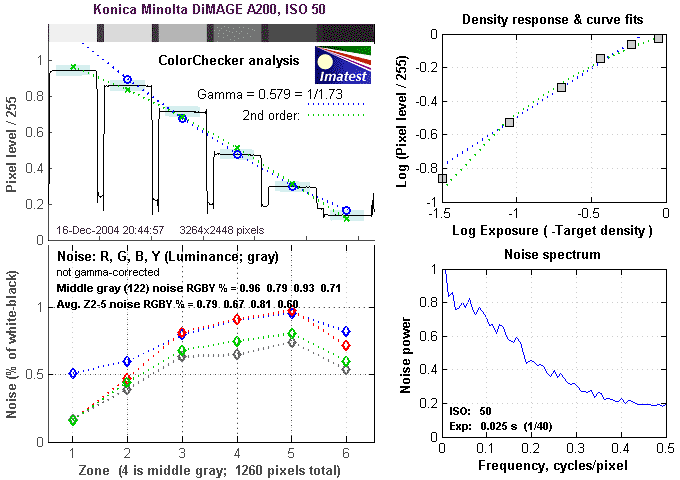
There's a lot in this particular graph, a lot more than I have room to go into
here. Bottom line, the DiMAGE A200's noise levels are quite low at ISO 50, although
the noise patterns are dominated by low spatial frequencies (seen in the way
the frequency graph is lumped up so sharply on the left side), which will tend
to make the noise a bit more evident than it would be otherwise.
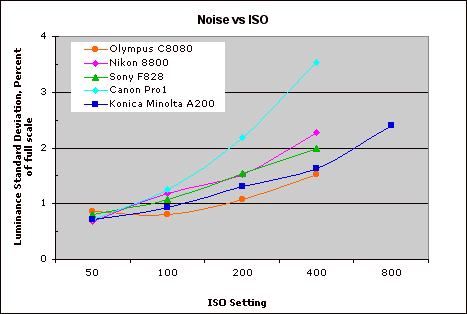
This chart compares the Konica Minolta DiMAGE A200's noise performance over
a range of ISOs against that of competing cameras. As you can see, the A200's
absolute noise levels are on the low side of average when compared to those
of competing 8-megapixel camera models. What this plot doesn't show though,
is how the cameras are achieving their noise levels. In the case of the
Olympus 8080 and the A20, both cameras use more aggressive noise-suppression
processing than do the Sony F828 or (particularly) the Canon Pro1. The result
is that their noise levels are lower, but tend to give up more detail in image
areas with subtle contrast. That said though, the A200 does a pretty good job
of managing that tradeoff, at least up to the ISO 400 level. (Its images at
ISO 800 are really of questionable value.)
The chart above shows consolidated results from spatial frequency response
measurements in both the horizontal and vertical axes. The "MTF 50"
numbers tend to correlate best with visual perceptions of sharpness, so those
are what I focus on here. The uncorrected resolution figures are 1210 line widths
per picture height in the horizontal direction (corresponding to the vertically-oriented
edge), and 1252 along the vertical axis (corresponding to the horizontally-oriented
edge), for a combined average of 1231 LW/PH. Correcting to a "standardized"
sharpening with a one-pixel radius increases this number slightly, to an average
of 1736 LW/PH, a very good number. Bottom line, there's a load of detail
in the A200's images, that can best be brought out by running its internal sharpening
at its lowest setting, and then sharpening after the fact in Adobe Photoshop(tm)
or other imaging software.
For the real techno-geeks, the two plots below show the actual edge response
of the A200, for horizontal and vertical edge. What's interesting in these plots
is how unusually restrained the A200's default sharpening is, and how little
it disturbs the underlying image detail.
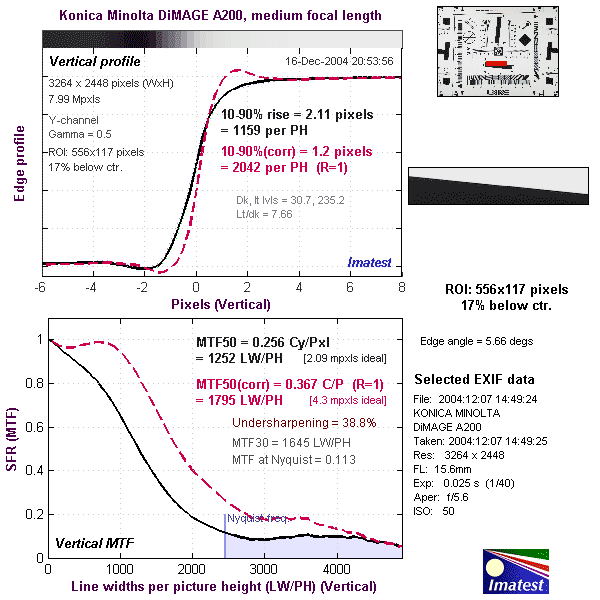
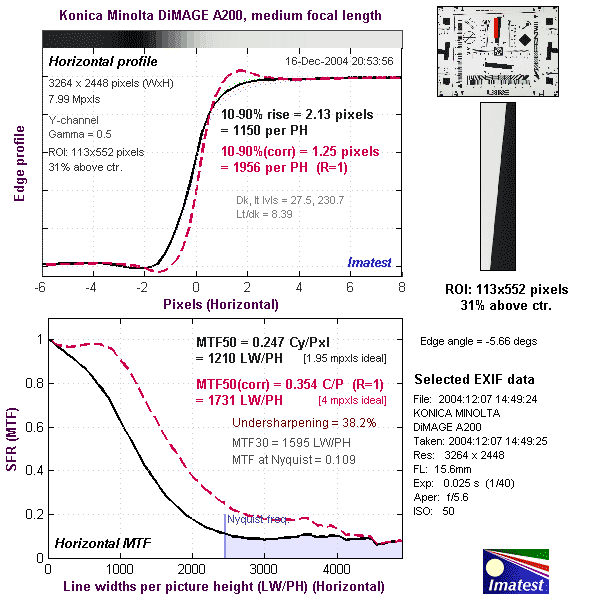
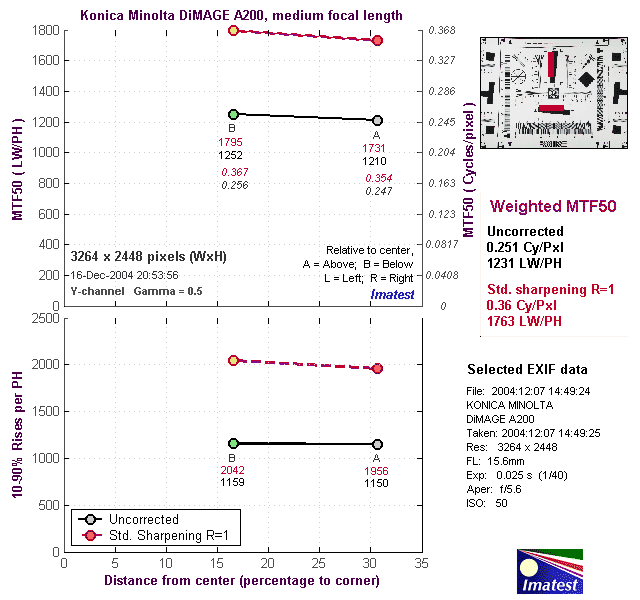

Follow Imaging Resource: